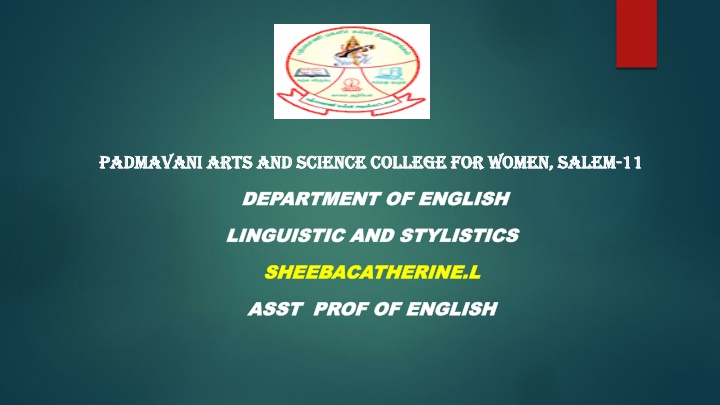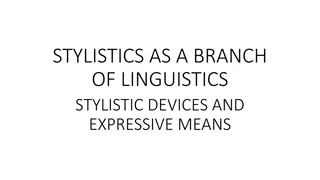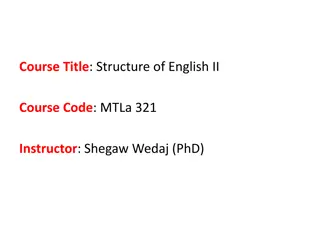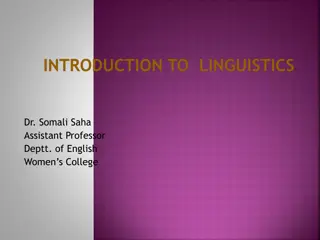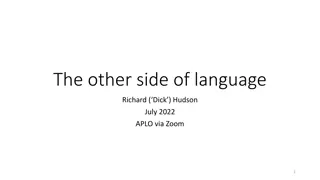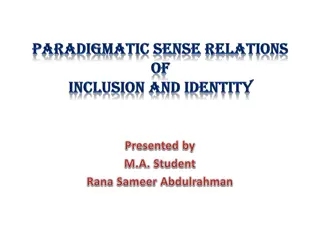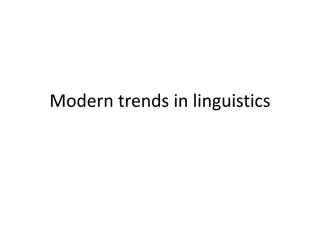Linguistics: Dynamic Study Influencing Various Fields
Linguistics, a dynamic and growing area, impacts diverse fields such as education, anthropology, sociology, and more. It encompasses branches like sociolinguistics, stylistics, psycholinguistics, and computational linguistics. The study involves examining language and society, literature, mind, and historical changes. The significance of linguistics in education is evident, with its cross-disciplinary nature expanding its application in early childhood development, psychology, and anthropology. Theories of meaning in semantics, like referential theory and speech-act theory, further enrich the study of linguistics.
Download Presentation

Please find below an Image/Link to download the presentation.
The content on the website is provided AS IS for your information and personal use only. It may not be sold, licensed, or shared on other websites without obtaining consent from the author.If you encounter any issues during the download, it is possible that the publisher has removed the file from their server.
You are allowed to download the files provided on this website for personal or commercial use, subject to the condition that they are used lawfully. All files are the property of their respective owners.
The content on the website is provided AS IS for your information and personal use only. It may not be sold, licensed, or shared on other websites without obtaining consent from the author.
E N D
Presentation Transcript
PADMAVANI ARTS AND SCIENCE COLLEGE FOR WOMEN, SALEM PADMAVANI ARTS AND SCIENCE COLLEGE FOR WOMEN, SALEM- -11 11 DEPARTMENT OF ENGLISH DEPARTMENT OF ENGLISH LINGUISTIC AND STYLISTICS LINGUISTIC AND STYLISTICS SHEEBACATHERINE.L SHEEBACATHERINE.L ASST PROF OF ENGLISH ASST PROF OF ENGLISH
Nature and Scope of Linguistics Linguistics is a growing and interesting area of study, having a direct hearing on fields as diverse as education, anthropology, sociology, language teaching, cognitive psychology and philosophy.
Branches of Linguistics sociolinguistics the study of language and society. stylistics the study of language and literature. psycholinguistics the study of language and mind. computational linguistics the simulation of language by the use of computers.
comparative linguistics the study of different languages and their respective linguistic systems. historical linguistics the study of language change over time. applied linguistics the study of language teaching.
BRANCHES OF LINGUISTICS SYNTAX PRAGMATICS LINGUISTICS SEMANTICS PHONOLOGY PHONETICS MORPHOLOGY
Significance of the study of Linguistics The use of linguistics in education is continuing to grow, and is often cross-disciplinary in nature. Not only is it utilized by language instructors, it is also used in early childhood development, psychology and anthropology education, as well. Linguistics is not only the study of language, but also includes the evolution and historical context of language, speech and memory development. It includes the structure and meaning of speech, and of written languages as well as an understanding of the context in which certain words are used.
THEORIES OF MEANING IN SEMANTICS Referential Theory of Meaning Use Theory of Meaning Speech-act Theory of Meaning Hermeneutic Theory of Meaning Post-Modern Theory of Meaning Consensus theory
Collocation, Association, Connotation Collocation is the relationship between two words or groups of words that often go together and form a common expression. Connotation, on the other hand, refers to the associations that are connected to a certain word or the emotional suggestions related to that word.
STYLISTICS Definition of Stylistics - Stylistics is a branch of linguistics which studies style in a scientific and systematic way concerning the manners / linguistic features of different varieties of language at different levels Literary Stylistics - General Stylistics - The Scope of Studies Literary stylistics : concentrating on the unique features of various literary works, such as poem, novel, prose, drama - General stylistics: concentrating on the general features of various types of language use, including literary discourses and other practical styles. General stylistics - Genres: news reports, advertisements, public speeches, scientific treatises, legal documents and other practical styles - Attitudes: formal and informal language - Media of communication: spoken English, written English, e-discourse - Regions: British English, American English and other regional dialects Social groups : standard and non-standard language.
